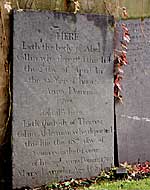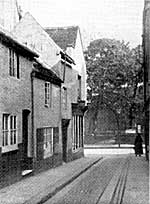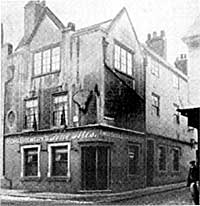< Previous | Contents | Next >
St Nicholas Street, St Nicholas Church Walk

Slate headstone to Abel Collins (d. 1705) in St Nicholas' churchyard (A. Nicholson, 2001).
As for the Churchyard, it is a dreary and desolate space which was much enlarged by the addition of a lower lying area in 1791. The first interment in this new addition was that of Jonathan Pearson, the mathematician. He was a schoolmaster in Nottingham and a man of some moment in his day and for many years edited "Poor Robin's Almanack." Thomas Booth, the eminent poacher whose unpleasant epitaph will be found on the south side of the Church lies in the older portion of the churchyard. His principal exploit seems to have been the poaching, about 1750, of a very fine deer from under the eyes of the Park Ranger at the point where the Park Offices are now situate. In this connection it is interesting to remember that the last wild deer near Nottingham was shot in 1800 by a man named Morley on the site now occupied by Sneinton Elements.
The Sundial on the south side of St. Nicholas Church is well worth study as is the beautiful lettering of many of the Swithland Slate tombs in the Churchyard. But, on the whole it is a depressing place and it is strange to think that Throsby writing about 1800 eulogised the beautiful prospect to be obtained from this Churchyard and said that he often resorted thither to enjoy the extensive view.
Just beyond the curious 17th century building now used as a parish room for St. Nicholas Church is the last remaining Vista in Nottingham. These Vistas were ordinary gardens and were provided in order to secure an extensive view into the open country from houses that were situated upon the opposite side of the road. They were generally laid out as formal gardens and this particular Vista contains one of the very few mulberry trees to be found in Nottingham. Its delightful 17th century gateway with reeded pilasters and urns forms a very pleasant object upon which to rest one's eye.

St Nicholas Street in the 1920s.
Almost opposite St. Nicholas Church is St. Nicholas Street which was known in 1255 as Venella Judaeorum or Jew Lane a name which clung to it right down to modern times, for it was the ghetto or dwelling place of the Jews in Nottingham.
Mention is made of Jews in England as early as 740 when they are noted on in the Ecclesiastical constitutions of Archbishop Egbert of York. The time of their entry into Nottingham is unknown, but as many of them followed the Conqueror's army it is probable that they arrived here in the 11th century. They were denied many rights which other people enjoyed, perhaps the most striking being that of burial, for they were only allowed to bury their dead in one graveyard in England, that being in London. However they were congregated together in Jewries or Ghettos. In 1181, that is in Henry II's time they were forbidden to possess mail or hawberk, but in spite of all this until the close of the 12th century the Jews in Nottingham lived on good terms with their Christian neighbours. However, during the reign of Richard I. relationships changed and the Jews gradually got into bad odour. In 1253 they were forbidden to have synagogues or meeting places anywhere unless they had existed during the reign of King John. They were taxed to the uttermost and in the 13th century every Jew above ten years of age was taxed. These taxes were probably levied in the aggregate and the synagogue officials were made responsible for the collection. Their costume up to this time was either that of their native land or a great black garment representing them as "mourners of Zion." In 1222 a statute was passed by which the local authorities were instructed to see that each Jew wore a badge the size, shape and colour of which was to be decided by the local authorities. Generally it was an oval badge in white, two inches wide by four inches long. Edward I. changed this colour from white to yellow and in 1275 they were compelled to wear a drab tabard to commemorate the tablets of stone. About 1278 the Jews had given great trouble to the government by clipping the coin of the realm which led to many executions throughout the country. There is a tradition that local Jews were involved in this massacre and that many of them were executed upon the Jews' gallows which stood in Shakespeare Street, but I have never been able to verify this tradition. Finally, on July 27th, 1290 all the Jews in England, some 1,600 were banished. There is a wonderful collection of Nottingham contracts or "sheteroths" preserved in the Record Office ranging from 1230 to 1290 which, if published and edited would probably throw a great deal of light upon early Nottingham history.
 The Royal Children public house before being
rebuilt in the 1920s.
The Royal Children public house before being
rebuilt in the 1920s.At the corner of St. Nicholas Street and Castle Gate stands the "Royal Children" public house and above its doorway will be seen the shoulder-blade of a whale which has probably been presented by some whaling captain either as a curio or an advertisement of his wares, in the days when whale oil was the principal illuminant for both public and private lighting. In 1688 just about the time that King James II's throne was tottering to its fall his daughter the Princess Anne finding the situation in Court intolerable fled from her father and took refuge in Nottingham bringing with her her children. She was lodged at the charges of the Earl of Devonshire and it is interesting to remember that Colley Gibber acted as an emergency waiter upon her Royal Highness and the Princess's popularity was only equalled by that of her children. I have heard it said that this house, now called the "Royal Children" was used as a lodging place and nursery for these youngsters, at any rate it gets its name from its connection with them. Directly opposite this inn is the modern vicarage of St. Nicholas Church which occupies the site of the old vicarage in which Gilbert Wakefield was born in 1756. This wonderful genius carried all before him in his early years being something of a preacher and was ordained as a clergyman of the Church of England; however, he resigned his office on doctrinal grounds and after various vicissitudes devoted himself to literary work, but in 1798 he wrote a pamphlet on the conduct of the French War which offended the government and he was imprisoned for two years in Dorchester gaol. His output of literature was abnormal and his speaking was eloquent to a degree. However, his use of violent language militated against the value of his advocacy.
Just by the side of this vicarage is the little passage known as St. Nicholas Church Walk, it is not of great importance now-a-days, but in reality is of considerable antiquity being the southern continuation of St. Nicholas Street.
